Water garden
This article needs additional citations for verification. (March 2021) |
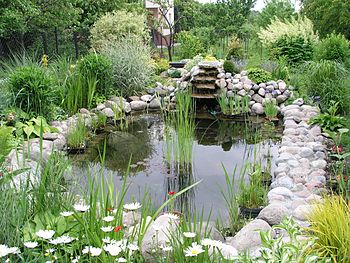
Water garden or aquatic garden, is a term sometimes used for
Water gardening is gardening that is concerned with growing plants adapted to lakes, rivers and ponds, often specifically to their shallow margins. Although water gardens can be almost any size or depth, they are often small and relatively shallow, perhaps less than twenty inches (50 cm) in depth. This is because most aquatic plants are depth sensitive and require a specific water depth in order to thrive; this can be helped by planting them in baskets raised off the bottom. A water garden may include a bog garden for plants that enjoy a waterlogged soil. Sometimes their primary purpose is to grow a particular species or group of aquatic plants, for example water lilies.
History
Water gardens, and water features in general, have been a part of public and private gardens since ancient
Description
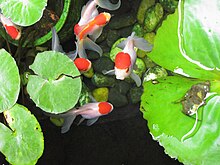
When the aquatic flora and fauna are balanced, an
, lining treatments, edging details, watercourses, and in-water and bankside planting can add visual interest and help to integrate the water garden with the local landscape and environment.Water features
In landscape architecture and garden design, a water feature is one or more items from a range of fountains, jeux d'eau, pools, ponds, rills, artificial waterfalls, and streams. Modern water features are typically self-contained, meaning that they do not require water to be plumbed in; rather water is recycled from either a pond or a hidden reservoir, also known as a sump.
-
Waterfall and pool in Bushy Park Water Gardens
-
TheVanderbilt Mansionpond
-
Ulm–Friedrichsau gardens
-
Singapore Botanic Gardens
Water follies
The sixteenth century in Europe saw a renewed interest in Greek thought and philosophy, including the works of Hero of Alexandria about hydraulics and pneumatics. His devices, such as temple doors operated by invisible weights or flowing liquids, and mechanical singing birds powered by steam, motivated several European palaces to create similar clever devices to enhance their public image.
In
-
A water folly/tea-pavilion in Mannheim's Chinese garden Duojingyuan
-
Partial view the garden of Villa d'Este in Tivoli (Italy)
-
Partial view of the garden of Hellbrunn Palace in Salzburg (Austria)
Stream gardens
On a constructed stream, placing rocks in the path of the water makes small patterns, rapids and waterfalls. The rocks disrupt the waterflow, causing splashing and bubbles that can make pleasant sounds and micro-habitats for plants, fish, and wildlife. Well-placed rocks can create splashing water that adds oxygen to prevent hypoxia: the more bubbles, the more dissolved oxygen in the water.
-
Stream Garden Trengwainton
-
Singapore Botanic Gardens
-
Scrape Burn, Dawyck Botanic Gardens
-
Stepping stones, Tollymore
Aquatic flora
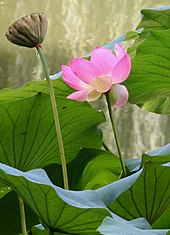
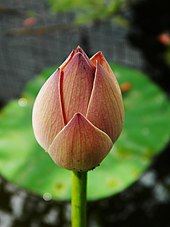
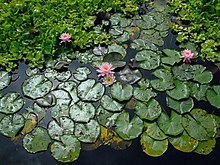
Water garden plants are divided into three main categories: submerged, marginal, and floating.
- Submerged plants are those which live almost completely under the water, sometimes with leaves or flowers that grow to the surface such as with the water lily. These plants are placed in a pond or container usually 1–2 ft (0.30–0.61 m) below the water surface. Some of these plants act as oxygenators as they create oxygen for any animals which live in a pond. Examples of submerged plants are:
- Hornwort (Ceratophyllum demersum)
- Water-lilies (Nymphaeaceae)
- Lotus (Nelumbo spp.)
- Featherfoil (Hottonia palustris)
- Eurasian water milfoil (Myriophyllum spicatum)
- Shining pondweed (Potamogeton lucens)
- Bladderwort (Utricularia spp.)
- Marginal plants are those which live with their roots under the water but the rest of the plant above the surface. These are usually placed so that the top of the pot is at or barely below the water level. Examples of these are:
- Iris or flag (Iris spp.)
- Water-plantain (Alisma spp.)
- Bulrush (Scirpus lacustris)
- Cattail (Typha latifolia)
- Taro (Colocasia esculenta)
- Arrowhead (Sagittaria latifolia)
- Bog-arum (Calla palustris)
- Pickerelweed (Pontederia cordata)
- Floating plants are those that are not anchored to the soil at all, but are free-floating on the surface. In water gardening, these are often used as a provider of shade to reduce algae growth in a pond. These are often extremely fast growing/multiplying. Examples of these are:
- Mosquito ferns (Azolla spp.)
- Water-spangle (Salvinia spp.)
- Frogbit (Hydrocharis morsus-ranae)
- Water lettuce (Pistia stratiotes)
- Water hyacinth (Eichhornia crassipes)
Some areas of the United States do not allow certain of these plants to be sold or kept, as they have become invasive species in warmer areas of the country, such as Florida and California.
Algae
Fauna
Fish
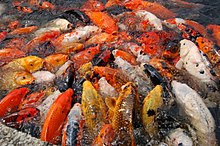
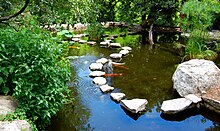

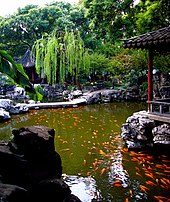
Often the reason for having a pond in a garden is to keep fish, often koi, though many people keep goldfish. Both are hardy, colorful fish which require no special heating, provided the pond is located in an area which does not have extremes of temperature that would affect the fish. If fish are kept, pumps and filtration devices are usually needed in order to keep enough oxygen in the water to support them. In winter, a small heater may need to be used in cold climates to keep the water from freezing solid. Examples of common pond fish include:
- Himedaka)
- Mosquitofish
- Rosy Red minnows
- White Cloud Mountain minnows
- Common minnows
- Goldfish (Common, Comet, Shubunkin varieties, Wakin and the Fantail varieties. With the possible exception of some of the fantail varieties, the fancy goldfish are not suited to pond life.)
- Crucian carp
- Koi (Nishikigoi, Butterfly Koi and Ghost Koi)
- Mirror carp
- )
- Grass carp
- Weather loach
- Stone loach
- Golden orfe
- Golden tench
- Golden rudd
- Gudgeon
- Red shiner
- Three-spined sticklebacks
- Eel
- Channel catfish
- Bluegill
- Pumpkinseed
- Black bass
- Sturgeon
- Snakehead
- Goby
Crustacean
- Crayfish
- Freshwater prawn
Snails
- River snail
Small aquatic
Herpetofauna
Ponds located in suburban and rural areas often attract
.Bird
Predators
Garden ponds can attract attention from predators such as (in North America) raccoons, herons, snakes, and domestic cats. These predators can be a danger to fish. Owners of koi are often particularly careful to create protected areas as some varieties are very expensive.
See also

- List of garden types
- Landscape architecture
- Aquascaping, arranging plants in an aquarium
- Rain garden
- Biochemical oxygen demand
- Chemical oxygen demand
- Wastewater quality indicators
- Biotope
- Aquaponics
Index categories
References
- OCLC 32431088.
- ^ "Carp". Department of Agriculture and Fisheries of Queensland. Retrieved Nov 22, 2018.
- ^ "Asian Carp Prevention and Control Act". Library of Congress. Retrieved May 26, 2023.














